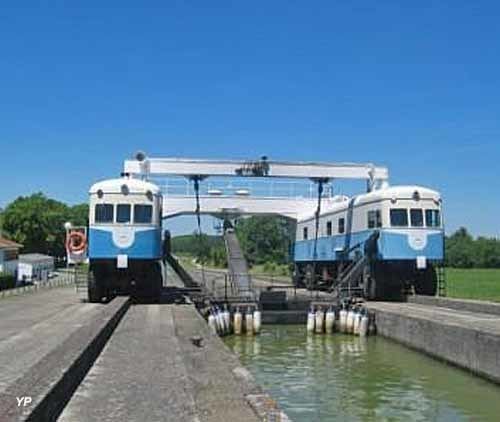 | ||
Similar Canal Latéral de la Garonne, Pont‑Canal Du Cacor, Fonserannes Locks, Agen aqueduct, Navigable aqueduct | ||
The Montech water slope is a type of canal inclined plane built on the Canal de Garonne, in the commune of Montech, Tarn-et-Garonne, South West France. It is managed by the publicly owned Voies navigables de France and it replaced a group of five successive locks.
Contents
- Map of Pente dEau de Montech 82700 Montech France
- Operating Principles
- Details of the machinery
- Design features
- Publicity
- References
Map of Pente d'Eau de Montech, 82700 Montech, France
Operating Principles
The principle of the water slope is based on a sloping channel up or down which a wedge of water retained by a water tight gate is moved. This technique was invented in the 19th century by the German engineer Julius Greve and described by the French engineer Jean Aubert in 1961. The Montech water slope was inaugurated in July 1974.
A sloping concrete channel is continuously fed by a small stream of water, thus overcoming any leakage at the seals around a movable gate. The movable gate spans the channel. The points of contact of the gate with the channel are tight but not fixed. Two adapted diesel locomotives, one on either side of the channel support the gate.
To allow a boat to ascend: the movable gate is lifted, the boat enters the channel, and then the gate is lowered. This isolates a wedge of water, on which the boat is floating, from the canal it has left. The locomotives ascend the slope pushing the water wedge in front of the movable gate. The boat rides on the water wedge. When the water level in the wedge matches that of the upper canal, an upper (non-moving) gate is opened and the boat is then allowed to float free.
To descend the process is reversed.
Details of the machinery
By virtue of its power and ingenuity the slope's mobile barrier is the key to the system. It consists of:
Each diesel electric locomotive develops 1,000 horsepower (750 kW) distributed to four drive motors, one on each of the four axles each with two large pneumatic tyres.
The three contact faces of the gate with the channel are equipped with seals to keep the wedge of water in place. The gate is raised or lowered using a hydraulic ram.
The shock absorber is a hydraulically levelled hinged metal frame. It allows boats to be connected to the gate during ascents and descents. An electronic system keeps motion gentle and smooth. Finally triple brakes slow the system without jerks.
Design features
Publicity
The Montech water slope was featured in an episode of the 2005 BBC television series Rick Stein's French Odyssey.
